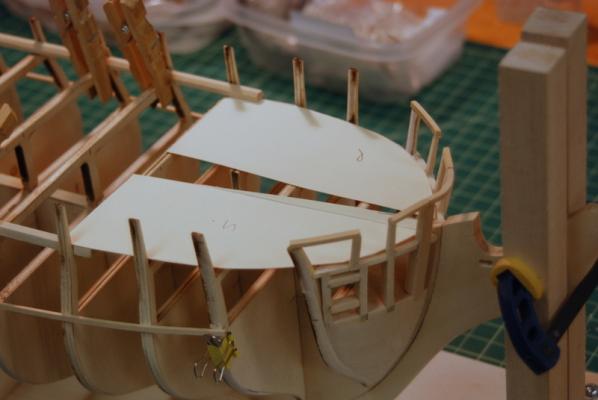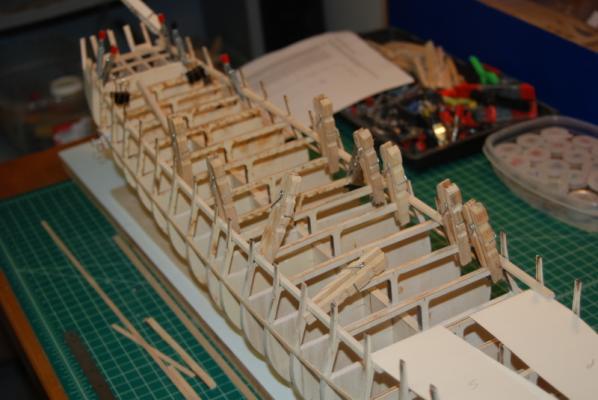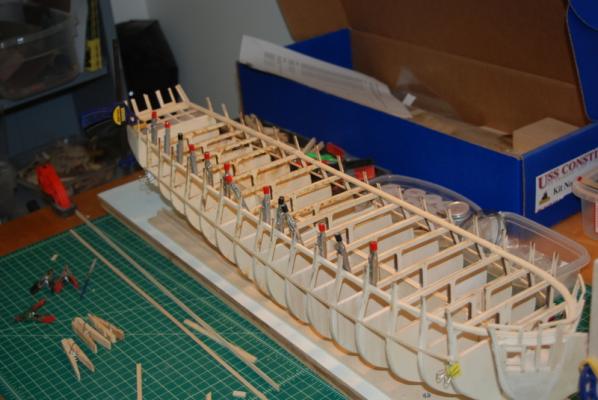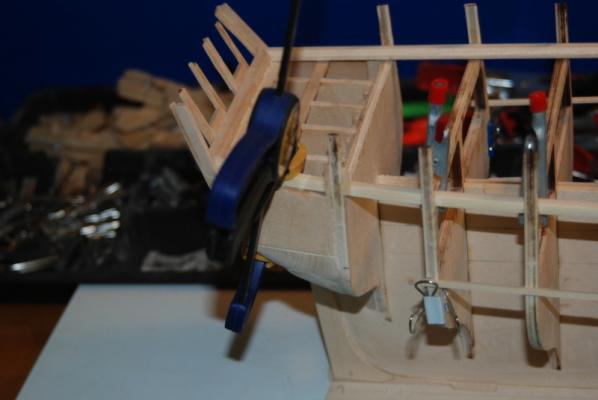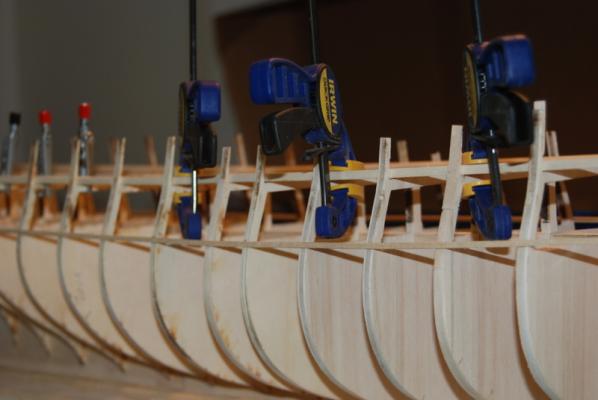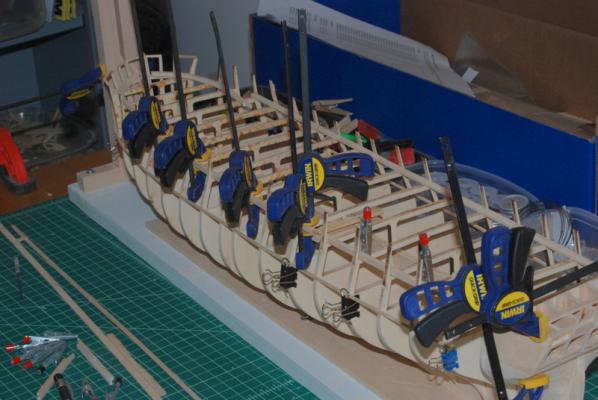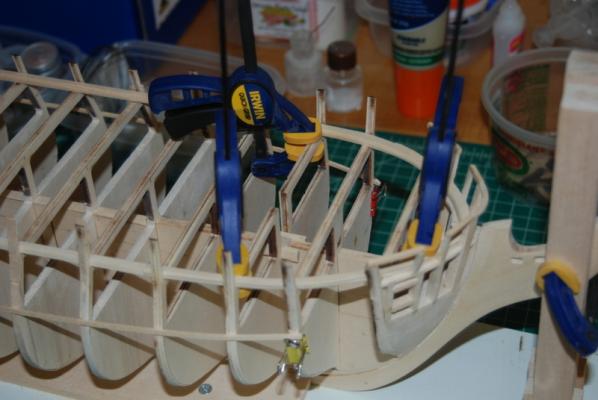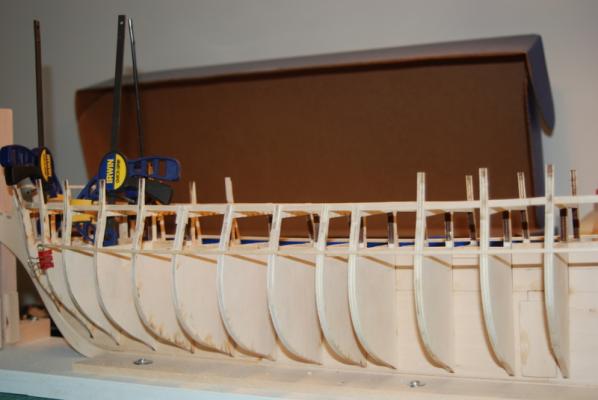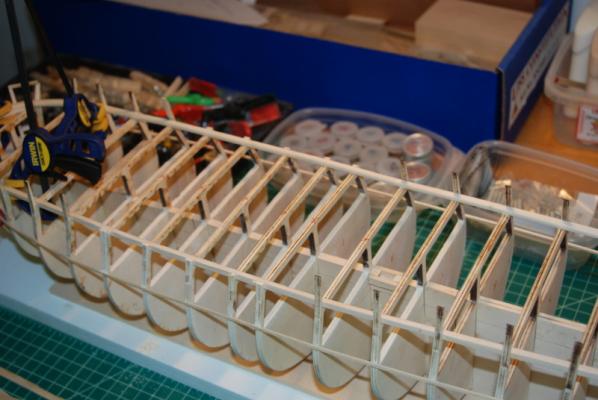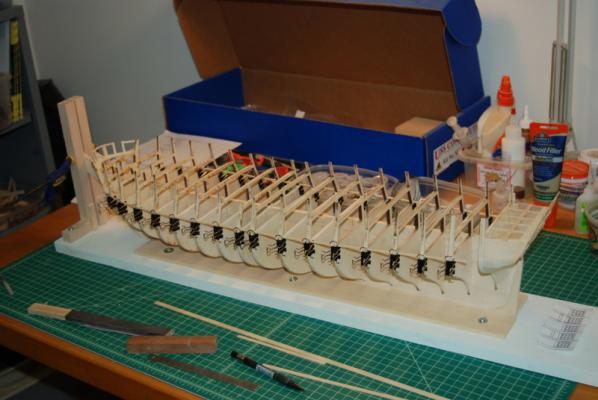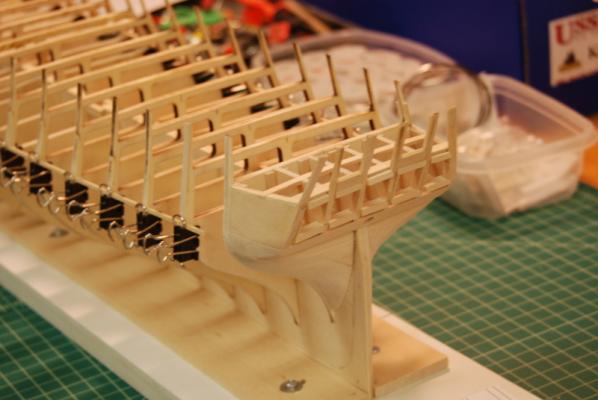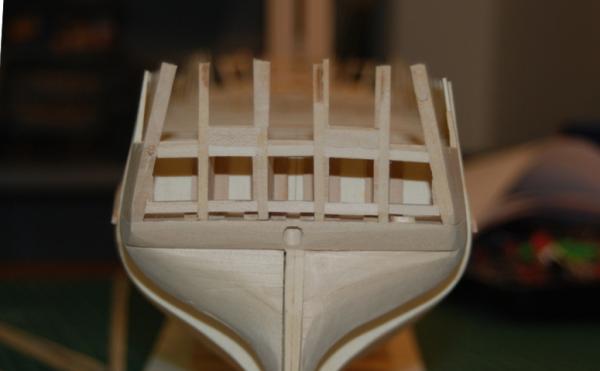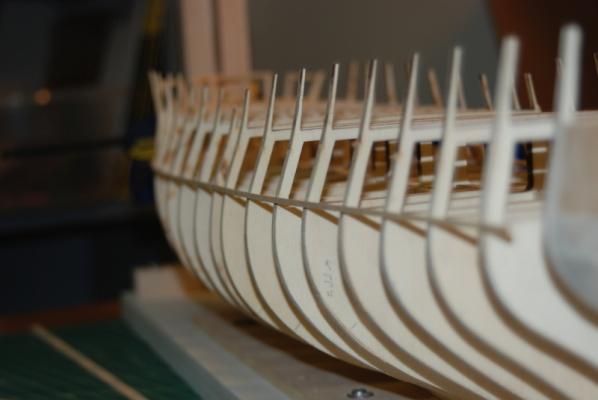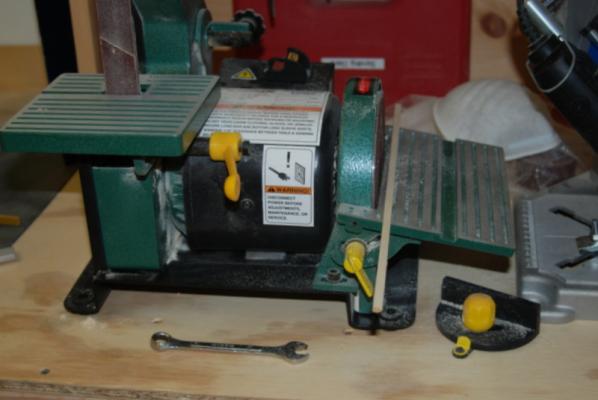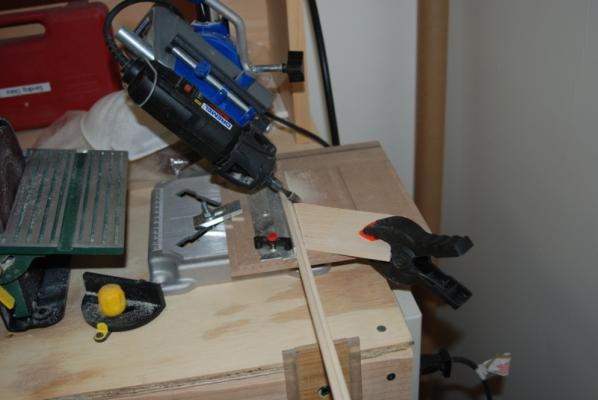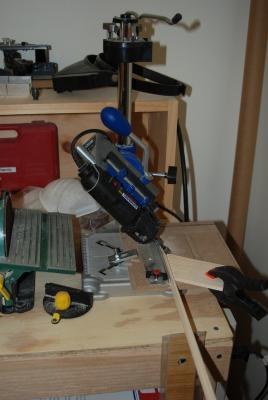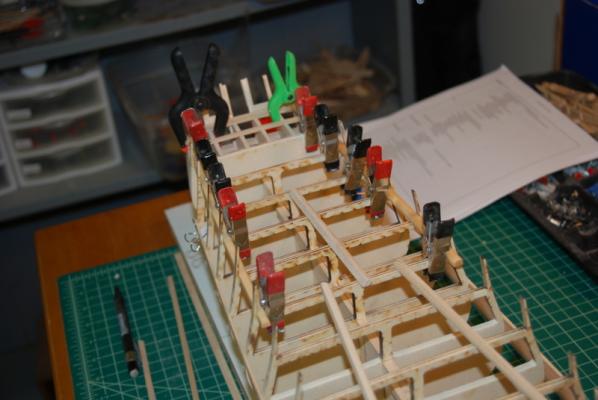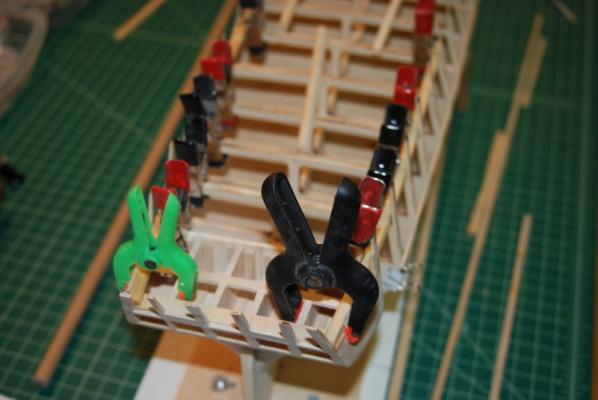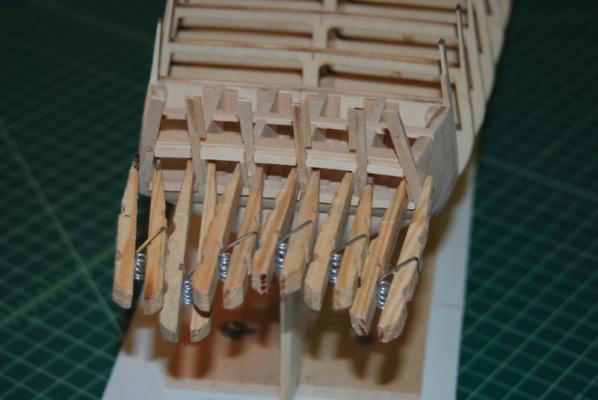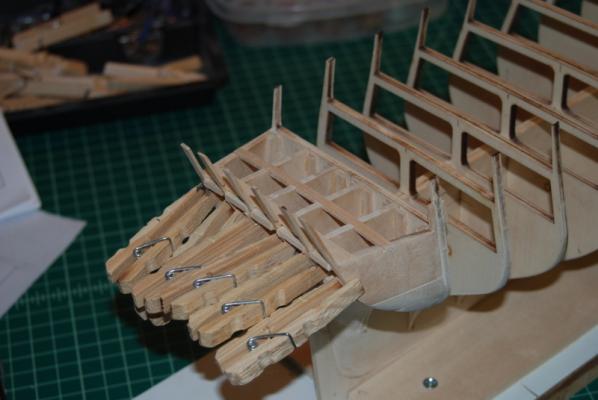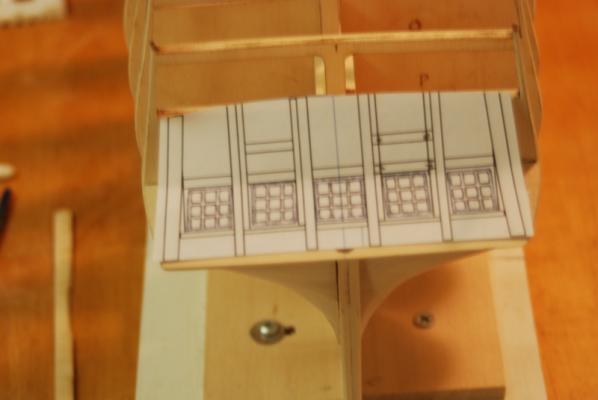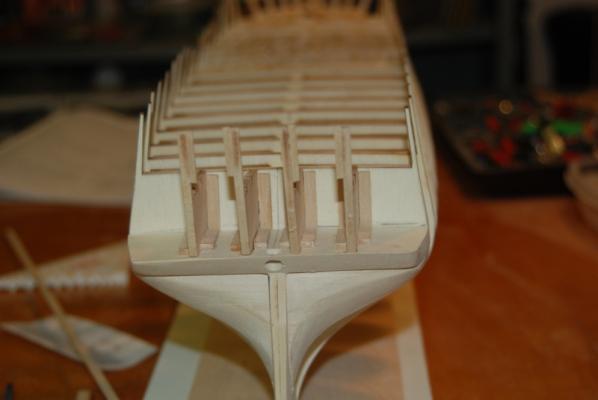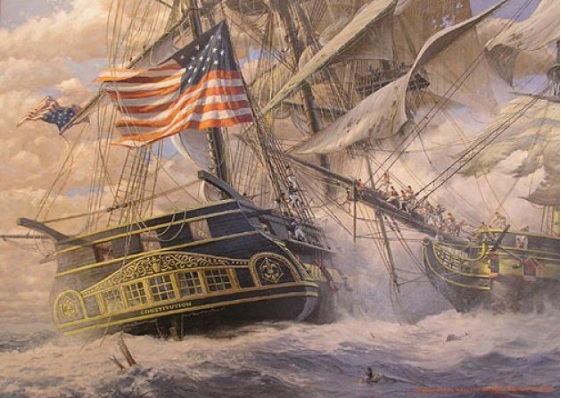-
Posts
2,407 -
Joined
-
Last visited
Content Type
Profiles
Forums
Gallery
Events
Everything posted by usedtosail
-
Ok, think about the planks that will wrap around the bow and the stern. they have to curve, so the outside edges of the bulkheads have to curve to match, so you get contact with the plank across the whole edge of the bulkhead. The plans for the bulkheads show a line on the ones that have to be bevelled. That line corresponds to the edge closest to the bow for the front bulwarks and closest to the stern for the rear bulwarks after you sand in the bevel. Just sand or carve straight from the existing edge to the line. Figure 1-4 in the instructions shows this pretty well. Leave a little extra for final sanding after you have all the bulkheads installed. This is where you will make sure the planks make a smooth run all the way along the hull, which is called fairing. I hope this helps.
-
Well, the soaked and bent waterways held their shape just fine. I did add a strip to the corner of the transom for the ends to fit in, so I re-soaked them and stuck them out the transom to get more curve in the stern. I also soaked and bent the other side pieces to the bulwark supports. While those were drying, I made up two templates from manila folder for the two bow waterways. I used the templates to cut these waterways out from some basswood sheet material, which is actually excess laser cut pieces from the kit. I glued these to some thinner sheets after getting them to shape inside and out, to get them to the same height as the other waterway pieces. I also made the waterways for the gun deck, using the one piece I had left from the kit and another that I had. These will go on when I can get into that area more easily. I cut the miter joints into the transom waterway and the ends of the two side pieces, and scarf joints in the other ends. I cut some of the scarf joints on the drill press with the end mill, but the two in front I had to do by hand. They came out the same in either case, not great, but OK since the pieces will be painted. I will need to practice a lot more before attempting these for wood that is to be left natural. I then started gluing the waterways in. Here are the two starboard side pieces being glued in. Being able to clamp that stern section so it was tight to the transom filler was a huge relief, as otherwise I don't know how I would have gotten that area to stay down. After I took this picture I could see that the middle sections were not being held down tight enough, so I broke out the bigger clamps. Why I didn't start with these I don't know, as they were perfect in not leaving any marks on the wood. And to be fair, here are the port side pieces being glued in. And finally, the bow sections being glued in. OK, here we go on the kit bashing part. I removed the bulwark supports to show the open waist area, and I have marked the deck beams that I will remove to add the gun deck. The beams will be replaced later with new beams made from basswood strips, as they will be shown in the open main hatch. Tomorrow, I will remove the marked deck beams. I sure hope this works.
- 1,350 replies
-
- constitution
- model shipways
-
(and 1 more)
Tagged with:
-
I finished up the stern framing by adding the bottoms to the chase ports. Since it will be a while before I will be planking the hull, I decided to add some battens to each side, to stabilize the bulkheads: I sanded the stern framing flush: Here is a view down the batten to check for fairness: I then started preparing the waterways. I used my disk sander to sand in the bevel along the bulwark supports: Then I put this crazy set up together to sand in the 45 degree bezel on the top and front of the waterway. It is the Dremel with a sanding drum in the Dremel workstation at a 45 degree angle, with the True Sander underneath so I could use it's fence. I put a finger board in there to hold the strip against the fence. All in all, I probably would have been better just to sand these by hand, but once I started putting stuff together it was fun to see if it would work. I didn't sand in the whole bevel, but enough to get it started. I then put the strip in my vice and set the vice to 45 degrees and planed and sanded it to the final bevel with a sanding block. This method worked but the Dremel put some pits in the face that I was able to sand out. That's why I didn't do the whole bevel this way. I made up the side waterways in two sections and I will connect them with a scrap joint, I think. I have enough overlap that if it doesn't work the first time, I can try again. I soaked the two back sections for about 30 minutes, then clamped them in place to dry. I need to add a post on the inside of the transom so I have an edge to connect these to, as well as the inside bulwark planking. There is nothing on the plans to indicate this, so I am not sure how the inside planking is otherwise supposed to end at the transom. You can't see it, but there is a small block of wood between those large clamps and the waterway to push them over, but I don't think it is enough yet. I may have to resoak and do this again. I'll see tonight how well these held the shape and how much more shaping they may need.
- 1,350 replies
-
- constitution
- model shipways
-
(and 1 more)
Tagged with:
-
I am having trouble with something that, to me, should be obvious. I am building the waterways for the Constitution and I don't know if I should add a section across the stern, at the inside of the transom. The plans don't show it there, but they also do not show the whole waterway anywhere, only a small section of waterway along the side. I went back through build logs and I find some models with it and some without. Of course, I could go into Charlestown this weekend and look for myself, but I thought I'd ask first, since we have so many Connie experts on this site. Since I am asking questions, here is another one. Is the waterway split under the bow sprit or does the bow sprit clear it so it can be one piece across the bow? Again, the plans don't show this anywhere, at least that I have found. I am hoping it is split as the clearance in this area is really tight. Thanks.
-
Mick, I had the same gap in the stern post.
- 625 replies
-
- bounty launch
- model shipways
-
(and 1 more)
Tagged with:
-
Thanks Patrick and Tim. Patrick - your Niagara looks great. I am so going to use that method for the flags on this one. I have never had much luck in the past getting realistic looking flags and that method with the aluminium foil looks good. Tim - Your cross section looks great too. I built the Santisima Trinidad cross section a few years ago, and it was a great introduction to planking and cannon rigging. I get a lot of comments from friends on that model still. I like all the details you have added to each of the decks.
- 1,350 replies
-
- constitution
- model shipways
-
(and 1 more)
Tagged with:
-
Oh, one more thing. I saw one of these large cutting mats in Blue Ensign's build log and thought it was great. It is 36" by 24" and makes a nice flat surface., I found this one Thursday on Amazon for only $20 US, and it was here Saturday. I am so happy with it, I just had to share. Thanks BE for the info on it.
- 1,350 replies
-
- constitution
- model shipways
-
(and 1 more)
Tagged with:
-
This week I have been working in the stern framing. I have the outer transom support pieces in and faired, and added the two deck beams. I left the middle one long so that I could hold it down to the curve of the deck using rubber bands (or as they say here in New England - elastics) I sanded these down to be flush with the support pieces, then started framing the stern windows. I added pieces for the top and bottom frames, then added the side frames. I first used thin (1/16" thick) pieces on the top and bottom frames, but since they were only edge glued to the supports they were not very sturdy (you can see a few of these in the above picture). I replaced them with thicker pieces that I could glue to the transom filler piece on the bottom, but the top pieces are still only edge glued, but the edge is bigger. In these pictures I have just glued in the side frames and they are all clamped and drying. The top frames can be seen above the clamps. You can see in this picture that I left the frames a little proud of the support pieces, so that I can sand them flush later. I will use the planking that will go onto the outside of the transom to make a recess around each window and then build the window frames to fit into those recesses. That's the current plan, anyway. I still have to add the bottom frames for the chase ports on the spar deck level. The top frame will be the taffrail. The windows are on the gun deck level.
- 1,350 replies
-
- constitution
- model shipways
-
(and 1 more)
Tagged with:
-
Nice start so far Al. You'll have fun with this kit. As others have said, you want to edge glue the planks. But, be careful with the amount of glue you use. I found it difficult to get the excess glue off the inside of the planks after I took the hull out of the form. Luckily, I only had a few spots to deal with.
-

Proxxon Micro MBS 240/E Band Saw Review
usedtosail replied to Blue Ensign's topic in Modeling tools and Workshop Equipment
Hi BE. I have two questions, if you don't mind. 1. How tall of a piece can be cut, that is fit under the blade guide? It looks fairly tall. 2. Where did you get your desk cover? I have only seen those mats in 24" lengths or so. I would love to cover my work table like that, although I imagine that could be a little pricey. Thanks. -
Thanks for the review Jay. This looks like a great set up and I especially like your Bracket for the Dremel. I just wish I had an extra grand and a place to put the machine. Someday maybe... You asked about speed control. I know you can get a foot switch that will control the speed, but you are probably looking for something that will retain a constant speed.
-
Ah, she who must be obeyed. I know it will look great whatever color you end up with.
- 420 replies
-
Thanks Evan. That is a great tutorial for getting a nice wood effect.
- 446 replies
-
- Revell
- Constitution
-
(and 1 more)
Tagged with:
-
Welcome Nick and Tim, Thanks for following. I attached the two side supports and have started to sand them into shape. While I am doing that, I am also sanding back the transom filler piece, which you can see in the last picture I posted that it is a little long.
- 1,350 replies
-
- constitution
- model shipways
-
(and 1 more)
Tagged with:
-
Thanks Patrick. This is a tough decision because historical accuracy is important, too. In the end though, aesthetics to me are going to win out. Some progress this weekend on the stern framing. I transferred the support piece outlines to the last bulkhead and the transom filler block. I glued some small tabs along one side of these lines and let them dry some I then glued in the supports and the tabs on the other side and slid them up to the first tabs. I checked the alignment of the stern ends using a divider to make sure they were all parallel to each other I started beveling the two outside support pieces but quickly saw that if I hold them flush to the last bulkhead, the deck beam notches are too far forward and don't align with the inner support notches, and the stern uprights are also too far forward. So, I glued some extra wood to the front of these two pieces, which I will bevel to match the angles and put these pieces in the right place. I'll have pictures of that process later. In the mean time, I started to frame the windows. As you can see, I used two small piece of wood that were the same height as the bottom window frames to align them parallel to the transom filler block and with each other to be all the same height. I also made sure that these frames stand a little proud of the support pieces so they will get faired along with the support pieces when I sand the supports before planking. A lot more work to do on the stern, but it is nice having a start.
- 1,350 replies
-
- constitution
- model shipways
-
(and 1 more)
Tagged with:
-
Thanks dragzz. Russ, thanks for the tip. I have been looking at both the Hull model and the Corne painting of the period for a while too. There are some major differences, like the number of windows, and as others have discussed in their build logs there is really no good source. As you suggest the Hull model may be the best reference since is was made by the crew, but I am not crazy about that stern configuration. The Corne painting is better and does have some of the elements I like, but may have some inaccuracies because it was painted at a later time. That is one of the reasons i am calling this an 1812-ish build.
- 1,350 replies
-
- constitution
- model shipways
-
(and 1 more)
Tagged with:
About us
Modelshipworld - Advancing Ship Modeling through Research
SSL Secured
Your security is important for us so this Website is SSL-Secured
NRG Mailing Address
Nautical Research Guild
237 South Lincoln Street
Westmont IL, 60559-1917
Model Ship World ® and the MSW logo are Registered Trademarks, and belong to the Nautical Research Guild (United States Patent and Trademark Office: No. 6,929,264 & No. 6,929,274, registered Dec. 20, 2022)
Helpful Links
About the NRG
If you enjoy building ship models that are historically accurate as well as beautiful, then The Nautical Research Guild (NRG) is just right for you.
The Guild is a non-profit educational organization whose mission is to “Advance Ship Modeling Through Research”. We provide support to our members in their efforts to raise the quality of their model ships.
The Nautical Research Guild has published our world-renowned quarterly magazine, The Nautical Research Journal, since 1955. The pages of the Journal are full of articles by accomplished ship modelers who show you how they create those exquisite details on their models, and by maritime historians who show you the correct details to build. The Journal is available in both print and digital editions. Go to the NRG web site (www.thenrg.org) to download a complimentary digital copy of the Journal. The NRG also publishes plan sets, books and compilations of back issues of the Journal and the former Ships in Scale and Model Ship Builder magazines.


